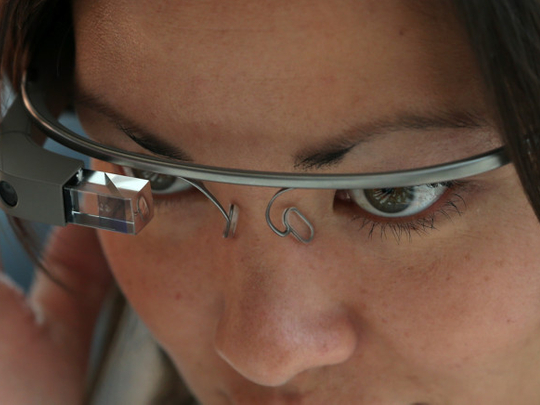
Dubai: The future is here and it’s glass – Google Glass to be precise.
And this new invention could have a far more profound impact in shaping our world.
If you have arrived late to the party, here’s a bit of info. Google Glass is a computer loaded onto sunglasses. And it can click images, record video, surf the net and do a whole lot more. Except maybe boil an egg.
Technology gurus are already calling wearable computers the next big shift in technology, the same way smartphones marked a leap from computers. And with Apple and Samsung already burning the midnight oil thinking of ways to make wearable technology work in different areas, it could indeed be the next ‘in’ thing.
NEXT BIG THING
“Wearable technology is the next wave,” said Ashish Panjabi, COO of Jacky’s Electronics. “We don’t need to watch Iron Man to imagine this, it’s becoming a reality bit by bit.
Ramy Kandil, Google MENA PR, told XPRESS how the new technology works. “Glass is a new wearable technology that goes beyond what you can do with a smartphone to free your hands and attention, making it easier for you to access the information you want and communicate with the people you care about. The display is up high and can be controlled by your voice, so you can live in the moment without looking down repeatedly or rummaging in your purse or pocket.”
There’s a small screen above one eye (according to Google the display is “the equivalent of a 25-inch high definition screen from eight feet away”) with motion sensor, camera and microphones that can take pictures and videos, provide turn-by-turn directions through Google Maps (connected wirelessly through your smartphone).
You can also surf the net, access mail, Facebook, Twitter, etc (Glass-enabled Facebook and Twitter apps have already been launched) by connecting through your phone. You can also ‘ask’ the device to do things and allow networking contacts to see in real time what the wearer sees through the device camera, and retrieve info from the web by connecting wirelessly to a user’s cellphone.
Wait, there’s more. The device can also be used to make phone calls and receive (on the screen) and send (voice command) text messages. “The potential of Google Glass depends on how innovative app developers get. Who would have thought five years ago that a smartphone which was typically seen as a business device, would be used extensively for gaming, health applications, a music player, an alarm clock or a navigation device?,” says Panjabi.
However, even as Google has won fans across the globe for its standout invention, others are queasy about the potential for misuse, given the fact it can click images and record far less conspiciously than other devices.
Kandil allayed such fears saying protecting the privacy and security of users’ data is top priority at Google. “Central to that is offering easy-to-use controls that allow people to manage information they store with Google. You sign into a Google account when you use Glass, which means you have controls: e.g. photos and videos you take with Glass will appear in your private Instant Upload album on Google+; you can share content with your Circles.
“The privacy and security of the data that users store with Google is central to our approach to handling government requests for their information. This is no different for Glass,” he said.
Panjabi also dismissed such fears. “Some years ago there was an uproar when mobile phones had built-in cameras. Saudi Arabia banned camera-phones but over time the realisation came that this was the way forward. I expect the same to happen with Google Glass,” he said.
NO WORD ON UAE LAUNCH
As for the product coming to the UAE, Kandil said: “The Glass Explorer program is only available in the US. We have no more information regarding its expansion elsewhere,”
He said it’s still early days for the project. “Glass is still in its early stage. It isn’t the sort of technology you can develop in a conference room - we really need people to take it out into the world and see what they’d like to do with it across a wide range of hobbies, lifestyles, and environments. That’s why we’re working so hard on the Glass Explorer program - the Explorers will be the people who will help us shape the future of this technology and how it will be used.”
The Glass Explorer was unveiled officially at last June’s Google I/O conference and is not expected to be available to consumers until next year (a few thousand early adopters paid $1,500 (Dh5,509) for the device), but the tech world is already looking through the glass at a whole new world of possibilities.
And yes, don’t be surprised if people exchange their goggles for Googles, come 2014!












